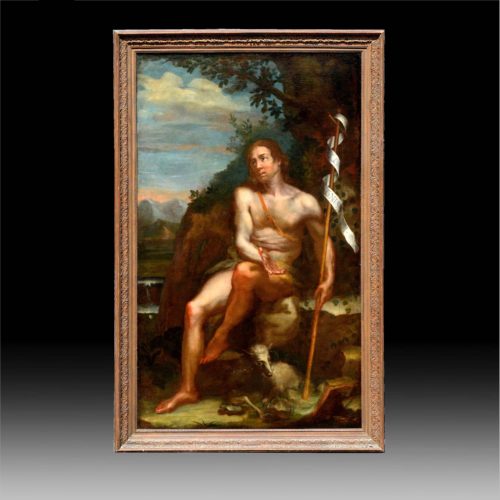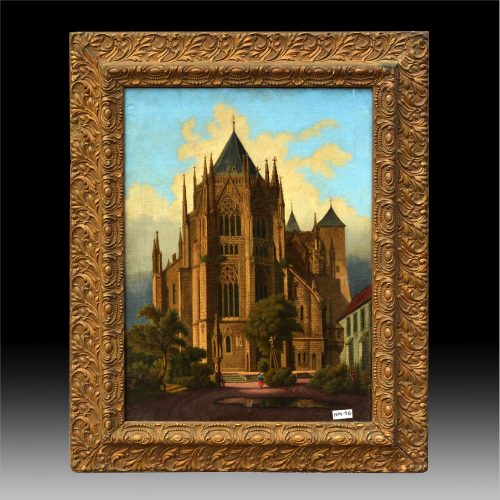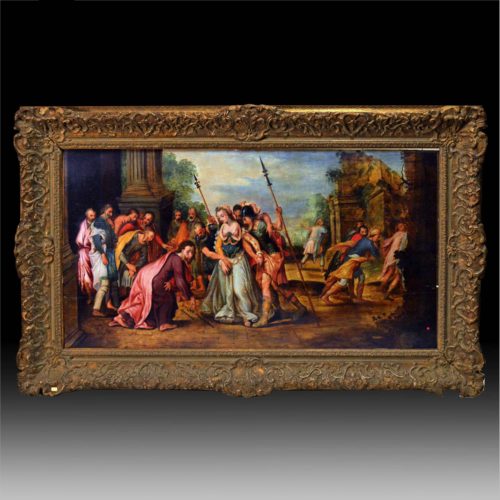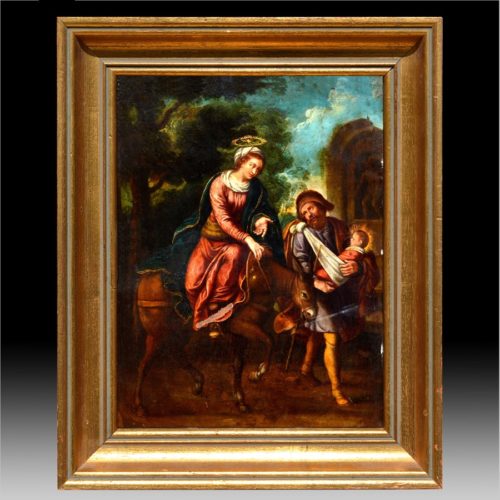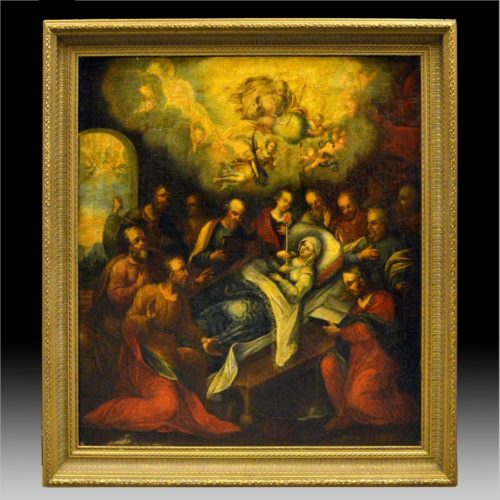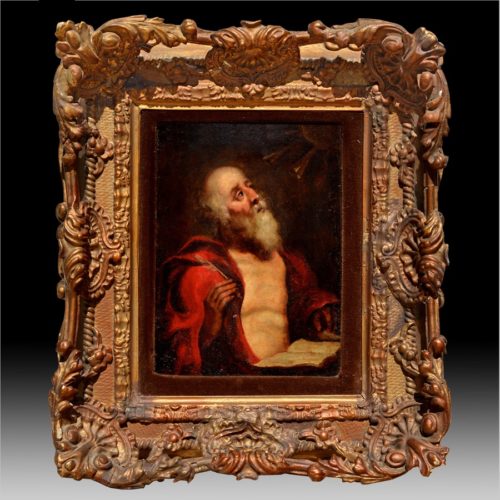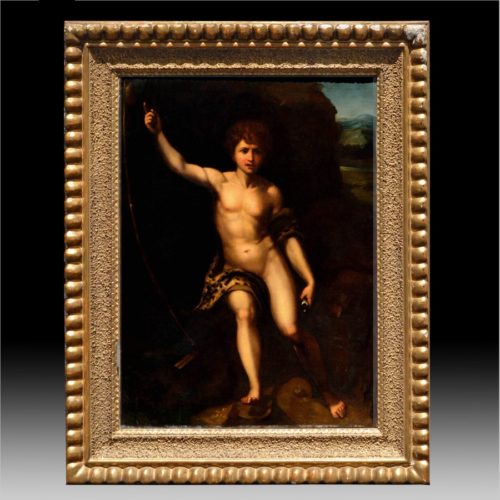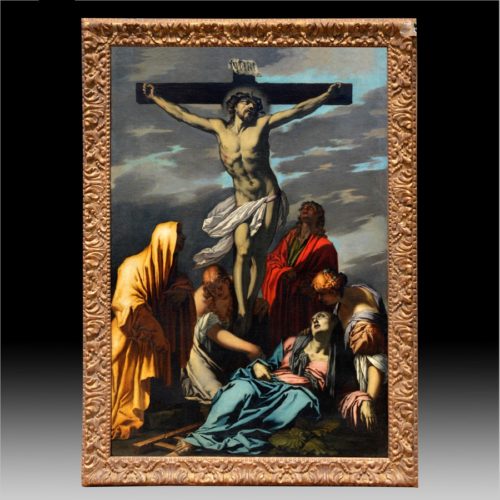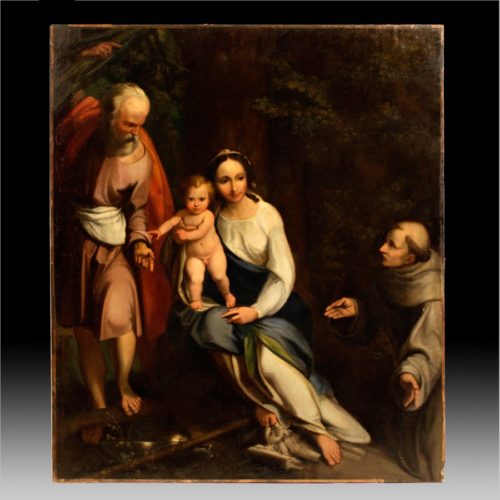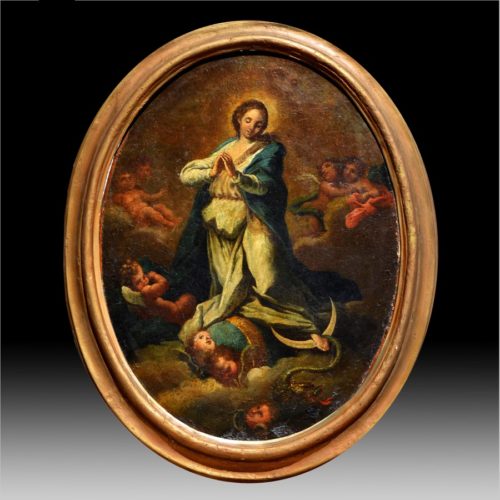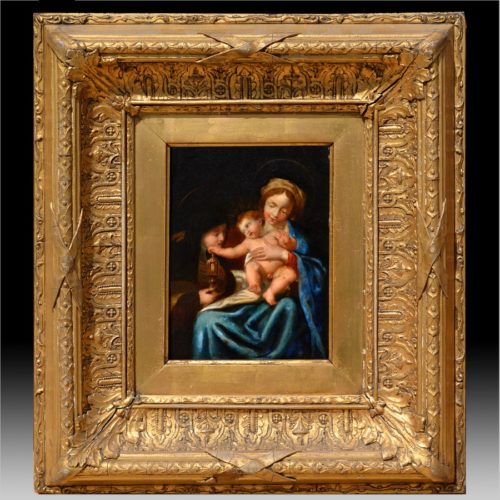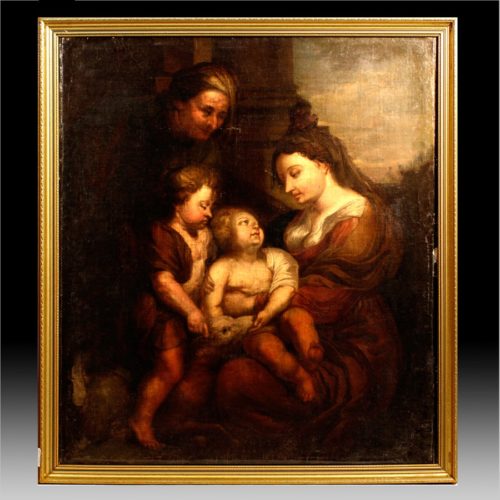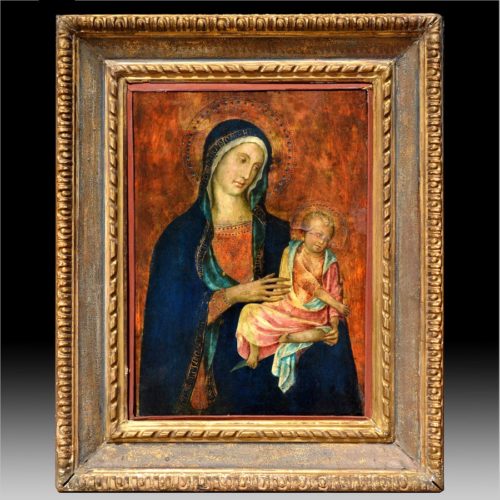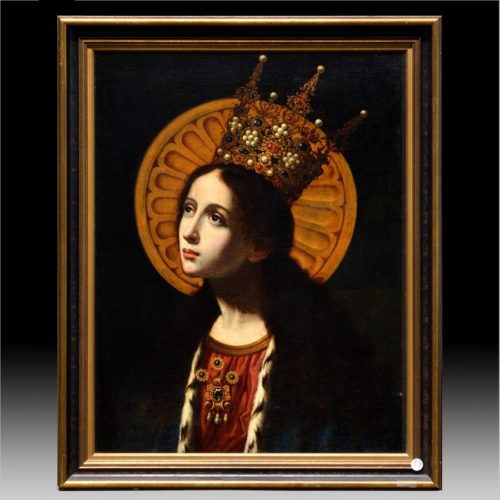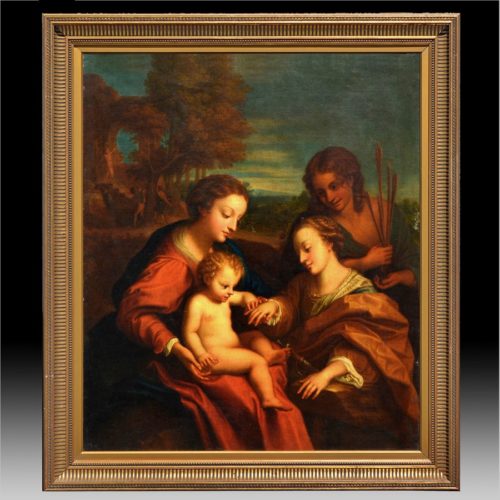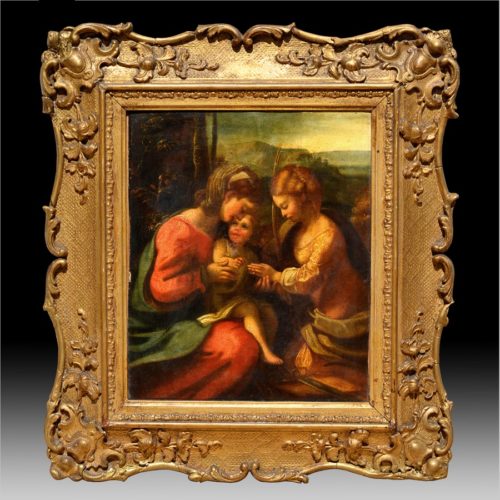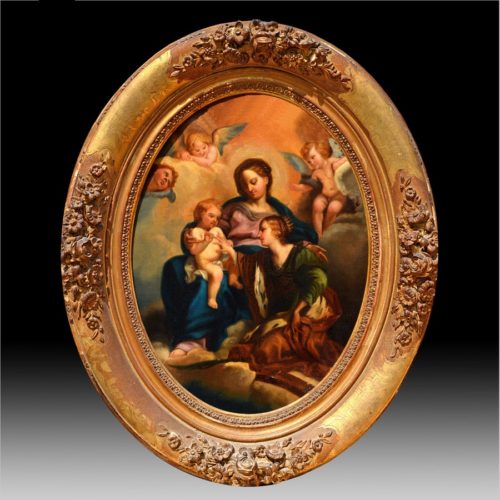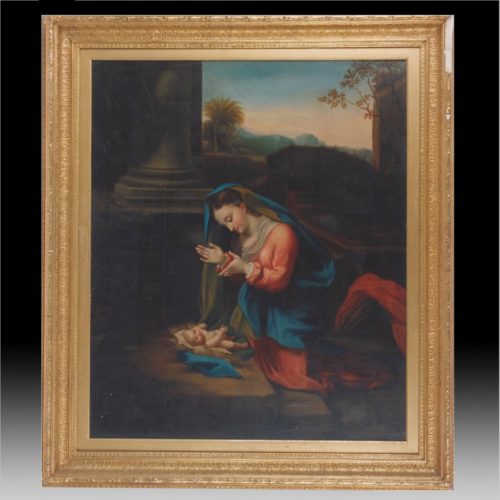-
Saint John the Baptist in the Wilderness Oil on Canvas
-
Continental School, 19th Century "The Cathedral" Dated 1874, Oil on canvas 26 x 18 1/4 inches (66 x 46.4 cm)
-
Pieter Aertson (Dutch, 1507-1575) Virgin Mary Oil on panel 22 ½” x 41 ½” Inscribed lower left Pieter Aertsen (Amsterdam, 1508 – 3 June 1575), called Lange Pier ("Tall Pete") because of his height, was a Dutch painter in the style of Northern Mannerism. He is credited with the invention of the monumental genre scene, which combines still life and genre painting and often also includes a biblical scene in the background. He was active in his native city Amsterdam but also worked for a long period in Antwerp, then the centre of artistic life in the Netherlands. His genre scenes were influential on later Flemish Baroque painting, Dutch still life painting and also in Italy. His peasant scenes preceded by a few years the much better-known paintings produced in Antwerp by Pieter Bruegel the Elder.
-
Frans II Francken (Flemish, 1581-1642) A Scene with the Madonna Oil on canvas 30 ½ x 23 centimeters CL102794-19 437402-2 @NB-1040 #39
-
Abraham Bloemaert (Spanish, 1566-1651) “Death of the Virgin” Oil on canvas 48 ½ x 44 ¾ inches Abraham Bloemaert (1566 – 27 January 1651) was a Dutch painter and printmaker in etching and engraving. He was one of the "Haarlem Mannerists" from about 1585, but in the new century altered his style to fit new Baroque trends. He mostly painted history subjects and some landscapes. He was an important teacher, who trained most of the Utrecht Caravaggisti, at least for a period.
-
Hendrik van Balen 1611-1654 “Saint Jermone” Oil on Copper 8 ¼” x 6’’ (21 x 15.3 cm) CL102794-65 310883-2
-
After Raphael (Raphael Sanzio da Urbino)(Italian, 1483-1520) “Saint John in the Wilderness” Oil on canvas 34 ½ x 25 inches CL102794-45 126521-2 @NB-1040 #14
-
Francesco Ruschi “The Crucifixion” Oil on canvas 60 ¼ x 40 ½ inches
-
Antonio Allegri, il Correggio “The Holy Family with Saint Francis” Oil on Canvas 47 ½” x 41” CL102794-64 374802-2
-
Lorenzo de Curo “The Immaculate Conception” Oil on canvas, Oval 32 ¼ x 24 1/8 inches (82 x 61.2 cm) CL 102794-56 322101-2 @NB-1040 260 (not online)
-
Carlo Dolci (Italian, 1616-1686) “The Madonna and Child with Saint Clare” Oil on copper 8 ¼ x 6 inches (21 x 15.3 cm) Carlo (or Carlino) Dolci (25 May 1616 – 17 January 1686) was an Italian painter of the Baroque period, active mainly in Florence, known for highly finished religious pictures, often repeated in many versions. He was born in Florence, on his mother's side the grandson of a painter. Although he was precocious and apprenticed at a young age to Jacopo Vignali, Dolci was not prolific. "He would take weeks over a single foot", according to his biographer Baldinucci. His painstaking technique made him unsuited for large-scale fresco painting. He painted chiefly sacred subjects, and his works are generally small in scale, although he made a few life-size pictures. He often repeated the same composition in several versions, and his daughter, Agnese Dolci, also made excellent copies of his works. Dolci was known for his piety. It is said that every year during Passion Week he painted a half-figure of the Savior wearing the Crown of Thorns. In 1682, when he saw Giordano, nicknamed "fa presto" (quick worker), paint more in five hours than he could have completed in months, he fell into a depression. Dolci's daughter, Agnese (died circa 1680), was also a painter. Dolci died in Florence in 1686.
-
Sir Peter Paul Rubens (Flemish, 1577-1640) “The Madonna and Child with the Infant Saint John and Saint Elizabeth” Oil on canvas CL102794-52 140802-2 43 x 36 ½ inches (109.2 x 92.7 cm)
-
Duccio di Buoninsegna (Italian, 1255-1318) “The Madonna and Child” Oil on panel 18 ½ x 13 inches Duccio di Buoninsegna (Italian; c. 1255–1260 – c. 1318–1319) was an Italian painter active in Siena, Tuscany in the late 13th and early 14th centuries. He is considered to be the father of Sienese painting and, along with a few others, the founder of Western art. He was hired throughout his life to complete many important works in government and religious buildings around Italy. Duccio is credited with creating the painting styles of Trecento and the Sienese school, and also contributed significantly to the Sienese Gothic style. Although much is still unconfirmed about Duccio and his life, there is more documentation of him and his life than of other Italian painters of his time. It is known that he was born and died in the city of Siena, and was also mostly active in the surrounding region of Tuscany. Other details of his early life and family are as uncertain, as much else in his history. Nevertheless, his artistic talents were enough to overshadow his lack of organization as a citizen, and he became famous in his own lifetime. In the 14th century Duccio became one of the most favored and radical painters in Siena. CL102794-10 561202-2 @NB-1040 #7
-
Francesco Curradi (Italian, 1570-1661) “The Madonna and the Angel Gabriel” Oil on canvas 26 x 20 inches (66 x 50.8 cm) CL102794-83/1 334002-2 @NB-1040 #16
-
Andrea (‘dAnqiolo) del Sarto (Italian, 1487-1531) “The Madonna of the Harpies” Oil on canvas 20 x 8 inches (50.8 x 20.3 cm) Andrea del Sarto (Italian: 1486–1530) was an Italian painter from Florence, whose career flourished during the High Renaissance and early Mannerism. Though highly regarded during his lifetime as an artist senza errori ("without errors"), his renown was eclipsed after his death by that of his contemporaries, Leonardo da Vinci, Michelangelo and Raphael. Andrea del Sarto was born Andrea d'Agnolo di Francesco di Luca di Paolo del Migliore in Florence on 16 July 1486. Since his father, Agnolo, was a tailor (Italian: sarto), he became known as "del Sarto" (meaning "tailor's son"). CL 102794-91 322101-2 @NB-1040 #18 OM-294
-
Antonio Allegri da Correggio “The Mystic Marriage of Saint Catherine” Oil on canvas 32 x 28 inches (81.3 x 71.2 cm) CL102794-78 3108802-2 @NB-1040 #68
-
Antonio Allegri da Correggio “The Mystic Marriage of Saint Catherine” Oil on canvas 10 ½” x 9” (26.7 x 22.8 cm) Antonio Allegri da Correggio (August 1489 – March 5, 1534), usually known as Correggio (Italian), was the foremost painter of the Parma school of the Italian Renaissance, who was responsible for some of the most vigorous and sensuous works of the 16th century. In his use of dynamic composition, illusionistic perspective and dramatic foreshortening, Correggio prefigured the Rococo art of the 18th century. He is considered a master of chiaroscuro. In 1503 he was apprenticed to Francesco Bianchi Ferrara in Modena, where he probably became familiar with the classicism of artists like Lorenzo Costa and Francesco Francia, evidence of which can be found in his first works. After a trip to Mantua in 1506, he returned to Correggio, where he stayed until 1510.
-
Francesco Solimena (Italian, 1657-1747) “The Mystic Marriage of Saint Catherine” Oil on canvas, Oval 12 7/8 x 9 5/8 inches (31.8 x 24.7 cm) CL102794-97 430602-2 @NB-1040 #61
-
Antonio Allegri, il Correggio “The Virgin Adoring the Christ Child” Oil on Canvas 31 ½” x 26 ½’’ 80 x 67.3 cm CL102794-79 761203-2 @AC-GN
-
Bartoloméo Estenban Murillo 1618-1682, Spanish “The Virgin with the Infant Christ Standing” Oil on canvas 62” x 42” 157.5 x 106.7 cm CL102794-63 9115603-2 @AC-NB

